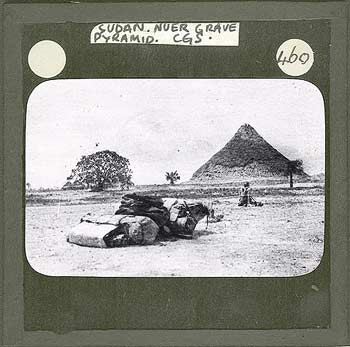Photographer
- John E. Allen
- Richard Buchta
- Jean Carlile Buxton
- E. E. Evans-Pritchard Collection:
- Godfrey Lienhardt
- Charles Kingsley Meek
- G. N. Morhig postcard series:
- Percy Horace Gordon Powell-Cotton
- Charles Gabriel Seligman slide collection
- Wilfred Patrick Thesiger
Edward Smyth Crispin (1874-1958)
View photographs by Edward Smyth Crispin.
 1967.26.187 slide
1967.26.187 slide
Dr Edward Smyth Crispin, graduated as a doctor in 1898 and volunteered as a civil surgeon in South Africa during the Boer War. When his contract ended, he accepted the offer of the Principle Medical Officer of the Egyptian Army. He arrived in Cairo in February 1890. In 1902, he was sent to Southern Sudan to deal with health problems in that area, and retired as Medical Director of the Sudan Government in 1922.
One of the lantern slides in the Charles Seligman collection seems to have been taken by Crispin, showing the earthen mound associated with the Nuer Prophet Ngundeng. Seligman describes it in his list as a grave pyramid, possibly since he was informed that Ngundeng was buried within his hut at the base of the mound. From the appearance of the earth on the pyramid, it resembles the state in which it appears in other 1901 photographs by Crispin published as Plates XXI Fig.1 & 2 (facing page 232) of C.G. & B. Seligman's Pagan Tribes of the Nilotic Sudan (London, Routledge 1932), as well as Plates XXVa & b of Evans-Pritchard's The Nuer (OUP 1940), where the photograph is credited to Crispin. The probability is therefore that this is another of Crispin's photographs of the mound from 1901, from a different aspect. Further research will hopefully shed more light on this.
Crispin's professional papers, as well as a number of photographs, are deposited in the Sudan archive of Durham University Library. One of particular relevance is listed, "2/25/29 Ngundeng's mound" which may be one of the photographs described here.

